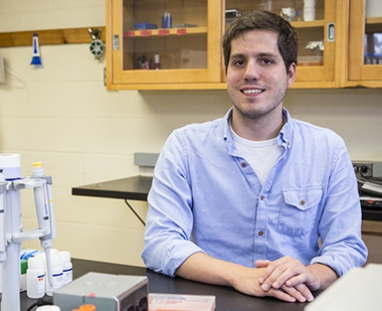Publisher's note: The author of this post, Doug Boyd, is a contributor to ECU News Services.
Graduate students share research on social media
Chances are East Carolina University doctoral students are either in the field, in the lab, headed to one or just back from the other.
To find out, just log on to their social media accounts.
Biology students Molly Albecker, Daniel Newhouse and numerous others are among a new generation of researchers - graduate students and early career professors - who are embracing social media, blogs and websites to communicate with the public and their peers.
ECU doctoral biology student Daniel Newhouse said social media allows him to discuss science with fellow researchers worldwide.
According to a 2014 Pew Research Center survey of scientists connected with the American Association for the Advancement of Science, 98 percent of scientists talk with the public about science and research. Fifty-one percent speak with reporters, 47 percent use social media to discuss or follow science, and 24 percent have blogged about science and research.
Twenty-two percent described it as either "very important" (4 percent) or "important" (18 percent) for career advancement in their discipline to promote their findings on social media such as Facebook or Twitter.
"People are telling their stories sooner and see that need to tell their stories," said Katie Mosher, communications director of N.C. Sea Grant.
"They do want to share their science with broader audiences. It's extremely important, and I think the graduate students and early career faculty are recognizing that in greater numbers."
Albecker, a doctoral student in the Institute for Coastal Science and Policy, said using social media allows researchers to communicate discoveries to people outside of academic circles. Social media also connects the researchers' personality to the work they are doing, she added.
"I find that it is the easiest way to send out links to neat articles, display pictures of my research-in-progress, and other science-based things I find interesting or funny," said Albecker, who uses her Twitter account (@Island_Frogger) as her primary means of science-based communication.
It also allows scientists to show their excitement and passion for their work, she added.
"In particular, connecting a face, a sense of humor and a real person to the research is especially important in recent times when scientists are sometimes portrayed as distant, unconnected and even untrustworthy," she said.
"Instead, researchers can show that they are regular people that are curious and motivated to understand our world and our place in it."
Ariane Peralta, (@ArianePeralta) an assistant professor of biology, was one of a trio of biology faculty members who recently spoke with students about using social media to talk about science.
"The pros are that online networking through social media works for many types of personalities, it evens out the playing field -- as an early career person you can connect with very established scientists in your field - (and) your reach is in real-time and global," said Peralta.
"Embracing social media as part of science allows you to enhance visibility of your work, curate your online presence and helps you keep up."
Social media also makes it easier to stay in touch with colleagues and scientists in other disciplines.
But be careful, she warned.
"There are no 'take backs.'"
Nate Holland (@onecynicmedic), a doctoral student in the Department of Physiology at the Brody School of Medicine, says it's important to give the public a chance to know what scientists are doing-and in terms the public can understand.
Social media helps ECU students gain a broader audience for their research. Doctoral student Molly Albecker was quoted recently in an online Wildlife Society article on her research about adaptations in frogs to salt and brackish water.
"I think services like Twitter are great for communicating with the lay public because the concise nature of the messages, such as character limits, really force me to distill my message to something easily digestible by the lay public and fellow researchers alike," he said.
His research focuses on the dangers of air pollution to the cardiovascular system.
"I'm always kind of amazed when I meet people that are unaware that air pollution isn't only bad for your lungs," he said.
"Using social media, I can quickly share recent publications or media coverage of my own work or work be done by researchers in my field or related fields."
Newhouse (@oldhouse5), a biology doctoral student, said he uses social media because it allows him to reach a much wider audience.
"Twitter is used by everyone, so it makes discussing research with scientists and the general public quite easy," he said in an email.
"Furthermore, one of the main benefits of using social media is interacting with other researchers that you may not normally be able to interact with. I'm able to engage in discussions with researchers from all over the world."
Social media also allows scientists to receive instant feedback about their methods and findings.
"I see questions about which methods to use and how to analyze data every day on my Twitter feed," Newhouse said.
"Often times, several researchers will respond within minutes each offering their ideas."
But social media feedback can go only so far.
"Nothing posted on social media is likely to reveal the nitty gritty experimental and statistical methods that ultimately determine whether your conclusions are accurate and appropriate," Albecker said.
Instead, she said, tweet links to publications.
Some scientific methods never get old.

A compilation of a few science-related messages that ECU researchers have posted on their Twitter accounts.

ECU student Molly Albecker is among a growing number of researchers who are using social media as a way to share ideas and research findings. Pictured above, Albecker works with Green Tree Frogs (Hyla Cinerrea) in the Howell Science Building. (Photos by Cliff Hollis)




